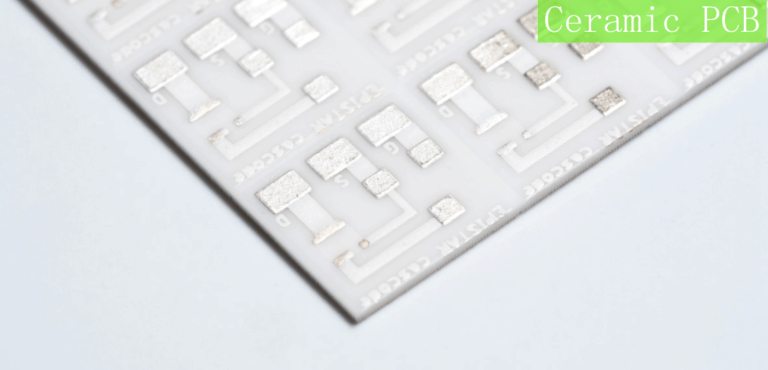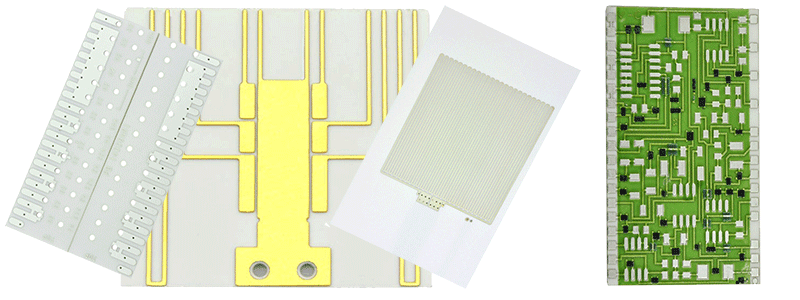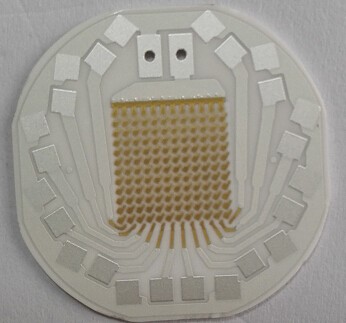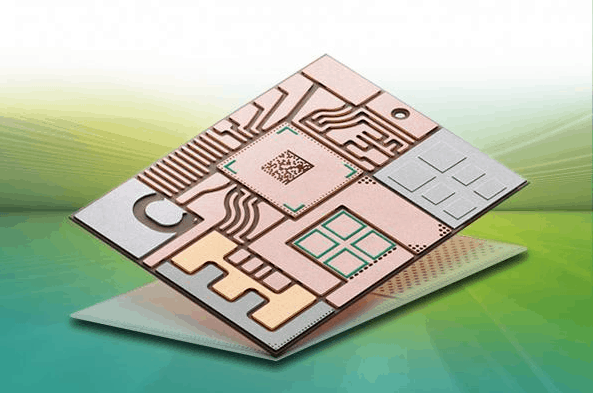Ceramic PCB
Ceramic Printed Circuit Boards (Ceramic PCB)
Apart from MCPCB, if you want to use PCB in high pressure, high insulation, high frequency, high temperature, and high reliable and minor volume electronic products, then Ceramic PCB will be your best choice.
Why Ceramic PCB has such excellent performance? You can have a brief view on its basic structure and then you will understand.
- 96% or 98% Alumina (Al2O3), Aluminum Nitride (AIN), or Beryllium Oxide (BeO)
- Conductors material: For thin, thick film technology, it’ll be silver palladium (AgPd), gold pllladium (AuPd); For DCB (Direct Copper Bonded) it’ll be copper only
- Application temp: -55~850C
- Thermal conductivity value: 24W~28W/m-K (Al2O3); 150W~240W/m-K for AIN , 220~250W/m-K for BeO;
- Max compression strength: >7,000 N/cm2
- Breakdown Voltage (KV/mm): 15/20/28 for 0.25mm/0.63mm/1.0mm respectively
- Thermal expansion conefficient(ppm/K): 7.4 (under 50~200C)
Click here to see more details about ceramic substrate.
According to different manufacturing method, current there’re three basic types for ceramic board:

Ceramic PCBs Material
Ceramic PCBs are usually made up of metal cores. For high thermal conductivity, aluminum nitride boards are ideal, providing greater than 150 w/mK. Since aluminum nitride boards are expensive, however, those opting for less expensive ceramic PCBs may find themselves with aluminum oxide boards, which offer about 18-36 w/mK. Both types will provide better thermal performance than metal core printed circuit boards, because there is no need for an electric layer between the core and the circuits.
Using silver for the printing traces — covered with glass for protection — will further increase thermal conductivity ( 406 W/mK). Other ceramic material options include boron nitride, beryllium oxide and silicon carbide. Ceramic boards are not finished with OSP, HASL or other traditional surface finishes because of the high operational temperatures. However, you can get your ceramic printed circuit boards with gold plating to protect the exposed pads if silver corrosion may be a problem, such as in high sulfur environments.

Ceramic PCB Thermal Conductivity
High ceramic PCB thermal conductivity is probably the leading reason more industries are turning to ceramics in their printed circuit boards and packages, as this material has a clear edge over plastics in this regard. Better CTE matching and hermetic sealing only add to the appeal of these materials. The challenge is that these materials, and the boards your ceramic PCB manufacturer makes from them, are considerably more expensive than materials for traditional printed circuit boards, which can add up significantly over the length of a high-volume job. However, the benefits of ceramic boards and the need for heightened thermal conductivity is so great, any company in a relevant industry that can afford to use ceramic boards will probably do so out of necessity.
While we can have an estimate of the level of thermal conductivity each ceramic board can provide, the final values will vary depending upon the manufacturing process, in addition to grain size and composition. We can offer a range of values that experts seem to agree upon.
Thermal conductivity for one of the most popular, although expensive ceramics — aluminum nitride — is one that many identify as over 150 W/mK, usually around 180 W/mK. However, studies find values ranging all the way from 80 W/mK to 200 W/mK at room temperature, with values dropping by more than one-third as you approach 100 degrees Celsius. Other thermal ranges we can identify at room temperature include 18-36 W/mK for aluminum oxide, 184 to 300 for beryllium oxide, 15 to 600 for boron nitride and 70-210 for silicon carbide.
Because the variations are so wide, it is difficult to pin down actual thermal conductivity numbers. Your best approach will be to do your own testing, record the values you obtain and use those in your future calculations.
Application of Ceramic PCB
- high-accuracy clock oscillator, voltage controlled oscillator (VCXO), temperature compensated crystal oscillators (TCXOs), oven controlled crystal oscillators (OCXOs);
- Semiconductor cooler;
- electric power electronic control module;
- high insulation & high pressure device;
- high temperature (up to 800C)
- high power LED
- High Power semiconductor modules
- solid state relay (SSR)
- DC-DC module power sources
- electric power transmitter modules
- Solar-panel arrays


Free PCB Request for Quotation (RFQ)
1. You can send email to us (tedchen163@yahoo.com). We will provide you with a
solution to make your PCB cost lower.
2. GoJGo receive your order,review the first,if there are questions,we will communicate with you
the first time and answer you about the lead time.
3. Our Engineering department will review this order with relevant departments,Produced in the best
process and in the shortest time.
4. Before shipment,we will talk with you about the shipping time and shipping method.
If you would like to customize your PCB type and place an order online, please click below to request a quotation.

